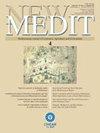叙利亚哈塞克省两个农业_x0002_生态区农民采用的雨水灌溉农业风险和管理策略。
IF 1.2
4区 经济学
Q3 AGRICULTURAL ECONOMICS & POLICY
引用次数: 0
摘要
基于对叙利亚哈塞克319名雨水灌溉农民的调查数据,本研究分析了雨水灌溉农民对风险的态度以及农民对风险和风险管理的认知。此外,运用多元回归分析方法,分析了社会经济特征与农民风险态度之间的关系。结果表明,降水短缺是威胁这两个地区农民的最重要风险源。此外,1区农民高度重视病虫害和自然灾害的风险。2区的农民更担心火灾造成的损失和缺乏政府支持。与以尽可能低的成本生产相关的财务战略被视为两个地区农民管理风险的重要战略。1区农民认为喷洒病虫害和流动性是最有效的风险管理策略,而2区农民则认为流动性和选择优质材料是一项重要策略。研究结果还表明,一些农场和农民的特征(如年龄、经验、教育程度、家庭规模、农场规模、家庭劳动力、扩展接触、非农场工作和合作社成员)显著影响了这两个地区农民的风险态度。本文章由计算机程序翻译,如有差异,请以英文原文为准。
Rain-fed agriculture risks and management strategies adopted by farmers in two agro_x0002_ecological zones in Al-Hasakeh province of Syria.
Based on survey data of 319 rain-fed farmers in Al-Hasakeh, Syria, this study analyses rain-fed farmers’ risk attitudes and farmers’ perceptions of risk and risk management. Furthermore, it analyzes, using multiple regression analysis, the relationship between socio-economic characteristics and farmers’ risk attitudes. The results demonstrate that precipitation shortage was the most important risk source that threaten farmers in both zones. Moreover, risks of diseases and pests and natural disasters were highly perceived by farmers in zone 1. Farmers in zone 2 were more concerned about fire damages and lack of government support. The financial strategy related to the producing at lowest possible cost is perceived as an important strategy to manage risk by farmers in both zones. Spraying for diseases and pests and liquidity are perceived as the most effective risk management strategies by farmers in zone 1, whereas farmers in zone 2 considered liquidity and choose good quality materials as an important strategy. The results also show that some farm and farmers’ characteristics (e.g. age, experience, education, household size, farm size, family labour, extension contact, off-farm work and Co-op Member) significantly impact the risk attitudes of the farmers in both zones.
求助全文
通过发布文献求助,成功后即可免费获取论文全文。
去求助
来源期刊

New Medit
AGRICULTURE, MULTIDISCIPLINARY-
CiteScore
2.00
自引率
30.00%
发文量
31
审稿时长
>12 weeks
期刊介绍:
New Medit is an applied economics journal, with a multidisciplinary approach, aimed at providing insights into the economic and the social transformations of agro-food sector, rural societies as well as local development and bioeconomy in the Mediterranean Basin.
Manuscripts submitted to NEW MEDIT generally should deal with wide-ranging topics that can be extended to other countries where organisational, production and market conditions and the related development policies may emerge at the corporate or regional level.
 求助内容:
求助内容: 应助结果提醒方式:
应助结果提醒方式:


